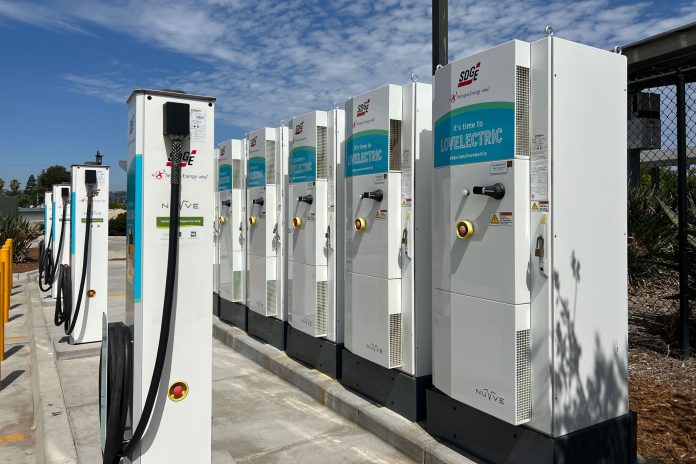Utility San Diego Gas and Electric (SDG&E) is opening the first vehicle-to-grid project in Southern California at Cajon Valley Unified School District.
The utility provided a live demonstration of the bi-directional charging necessary for V2G at the school district on Tuesday. The five-year project will use six 60 kWh bi-directional DC fast chargers from Nuvve to provide power to Cajon Valley’s electric school buses (ESBs) while also drawing energy from the bus batteries to offset peak demand in the community and in the case of an emergency.
Tysen Brodwolf, the district’s director of transportation who spoke of her electrification experiences during the Green Bus Summit at STN EXPO Reno on July 17, told School Transportation News that six of the district’s seven LionC ESBs—five 2019 models and one 2021—are participating in the pilot.
“The pilot starts once the V2G is up and running, data will then be collected and reported for five years from that point,” explained Brodwolf. “As we were able to discharge back to the grid on June 30, I do anticipate CVUSD entering the collecting and reporting phase of the pilot for the 2022-2023 school year.”
She noted that all the buses are equipped with telematics and data loggers to track information. She said Cajon Valley recently partnered with energy and technology consultant Cadmus to evaluate the overall program.
“They interpret metrics such as miles per kWh consumption and how much energy the buses can put back into the grid,” she explained.
Brodwolf said she is optimistic the pilot will begin shortly. The first day of the new school year for Cajon Valley students is Aug. 17.
Cajon Valley’s ESB Makeup
Five of the electric school buses in use at Cajon Valley Unified School District near San Diego are 2019 models that are configured with three batteries at 132 kWh, said Director of Transportation Tysen Brodwolf. The other two ESBs are 2021 models and are configured with four batteries at 169 kWh.
“We received the first five in July and August of 2019, and they have been on the road since August and September of 2019,” she continued. “The 2021 models we received [this] spring … and will start on routes for the upcoming fall semester in August. We have an eighth Lion on order.”
In a statement on Tuesday, SDG&E said the school district will be eligible to participate in the utility’s Emergency Load Reduction Program, which pays business customers $2 per kWH when exporting energy to the grid or reducing energy use during grid emergencies. Brodwolf added that she expects the district to generate revenue during the pilot not only from the Emergency Load Reduction Program but also from the Low Carbon Fuel Standard tax credits available in California.
Revenue aside, Assistant Superintendent Scott Buxbaum said V2G provides the opportunity for school buses to further support the classroom as well as the environment.
“We jumped at the opportunity to be part of this pilot project because of its potential to help us build a healthier community and better serve our students,” he said in a statement. “If we are able to reduce our energy and vehicle maintenance costs as a result of this project, it frees up more resources for our schools and students.”
Meanwhile, SDG&E said it is also developing V2G pilots with nearby San Diego Unified School District and Ramona Unified School District.
In April, Con Edison in New York released findings from a three-year V2G study of using three Lion ESBs operated for White Plains Public by contractor National Express. Nuvve supplied the bi-directional chargers. That study reported that the buses met the goal of achieving an average of 1.4kw hours per mile. The school buses also exceeded the goal of minimal electricity losses, in which 85 percent of the power in the batteries reached the grid. A press release noted that moving electricity through conductors always results in some loss.
Last summer, a Thomas Built Buses Saf-T-Liner C2 Jouley ESB battery system powered by Proterra that is operated for Beverly Public Schools by Highland Electric in Massachusetts discharged three megawatt-hours of electricity during 30 different occasions to regional utility National Grid in New England. The discharges allowed National Grid to lower demand on the grid during peak demand times.
Related: Green Bus Summit Panel Examines Leading Challenges of Fleet Electrification
Related: Green Bus Summit Panel Gives Tips on Fleet Electrification
Related: Nuvve Selected as Collaboration Partner with United States Department of Energy to Accelerate V2G Technology
Related: BYD Introduces Innovative and Safe Type A Battery Electric School Bus with V2G technology
Related: Nuvve Announces First-of-its-Kind V2G Hub at Blue Bird Factory to Optimize Electric Bus, Grid Utilization














